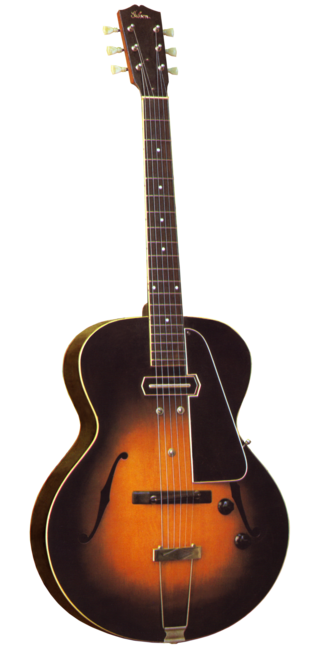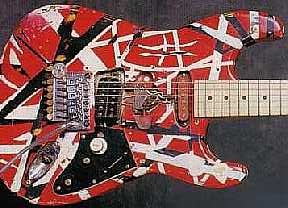
The bass guitar, electric bass or simply bass, is the lowest-pitched member of the guitar family. It is a plucked string instrument similar in appearance and construction to an electric or acoustic guitar, but with a longer neck and scale length, and typically four to six strings or courses. Since the mid-1950s, the bass guitar has largely replaced the double bass in popular music.

An electric guitar is a guitar that requires external amplification in order to be heard at typical performance volumes, unlike a standard acoustic guitar. It uses one or more pickups to convert the vibration of its strings into electrical signals, which ultimately are reproduced as sound by loudspeakers. The sound is sometimes shaped or electronically altered to achieve different timbres or tonal qualities from that of an acoustic guitar via amplifier settings or knobs on the guitar. Often, this is done through the use of effects such as reverb, distortion and "overdrive"; the latter is considered to be a key element of electric blues guitar music and jazz and rock guitar playing. Designs also exist combining attributes of the electric and acoustic guitars: the semi-acoustic and acoustic-electric guitars.

The guitar is a fretted musical instrument that typically has six strings. It is usually held flat against the player's body and played by strumming or plucking the strings with the dominant hand, while simultaneously pressing selected strings against frets with the fingers of the opposite hand. A plectrum or individual finger picks may also be used to strike the strings. The sound of the guitar is projected either acoustically, by means of a resonant chamber on the instrument, or amplified by an electronic pickup and an amplifier.

Audio feedback is a positive feedback situation which may occur when an acoustic path exists between an audio input and an audio output. In this example, a signal received by the microphone is amplified and passed out of the loudspeaker. The sound from the loudspeaker can then be received by the microphone again, amplified further, and then passed out through the loudspeaker again. The frequency of the resulting howl is determined by resonance frequencies in the microphone, amplifier, and loudspeaker, the acoustics of the room, the directional pick-up and emission patterns of the microphone and loudspeaker, and the distance between them. The principles of audio feedback were first discovered by Danish scientist Søren Absalon Larsen, hence it is also known as the Larsen effect.

A humbucking pickup, humbucker, or double coil, is a type of guitar pickup that uses two wire coils to cancel out the noisy interference picked up by coil pickups. In addition to electric guitar pickups, humbucking coils are sometimes used in dynamic microphones to cancel electromagnetic hum. Humbuckers are one of the two main types of guitar pickups. The other is single coil.

The Gibson ES-150 is a pioneering semi-acoustic electric guitar produced by Gibson Guitar Corporation. Introduced in 1936, it is generally recognized as the world's first commercially successful Spanish-style electric guitar. The ES stands for Electric Spanish, and Gibson designated it "150" because they priced it at around $150. The particular sound of the instrument came from a combination of the specific bar-style pickup and its placement, and the guitar's overall construction.

A pickup is a transducer that captures or senses mechanical vibrations produced by musical instruments, particularly stringed instruments such as the electric guitar, and converts these to an electrical signal that is amplified using an instrument amplifier to produce musical sounds through a loudspeaker in a speaker enclosure. The signal from a pickup can also be recorded directly.

A P.A.F., or simply PAF, is an early model of the humbucker guitar pickup invented by Seth Lover in 1955, so named for the "Patent Applied For" decal placed on the baseplate of each pickup. Gibson used the PAF on guitars from late 1956 until late 1962, long after the patent was granted. They were replaced by the Patent Number pickup, essentially a refined version of the PAF. These were in turn replaced by "T-Top" humbuckers in 1967, and production ended in 1975. Though it was not the first humbucking pickup ever, it was the first to gain widespread use, as the PAF's hum-free signal, tonal clarity, and touch sensitivity when paired with higher-gain amplifiers made the pickups popular with rock and blues guitarists. The PAF is an essential tonal characteristic of the now-famous 1957–1960 Gibson Les Paul Standard guitars, and pickups of this type have gained a large following.

The Fender Wide Range Humbucker is a humbucker guitar pickup, designed by Seth Lover for Fender in the early 1970s. This pickup was intended to break Fender's image as a "single coil guitar company," and to gain a foothold in the humbucker guitar market dominated by Gibson.

The Frankenstrat, also known as "Frankie", is a guitar created by Eddie Van Halen. Its name is a portmanteau of Frankenstein, the fictional doctor who created a monster by combining body parts of the recently deceased, and the Stratocaster, a model of electric guitar made by Fender.

Fender Telecaster Custom is a model of electric guitar made by Fender.

There are a number of well-developed microphone techniques used for recording musical, film, or voice sources or picking up sounds as part of sound reinforcement systems. The choice of technique depends on a number of factors, including:
Electric guitar design is a type of industrial design where the looks and efficiency of the shape as well as the acoustical aspects of the guitar are important factors. In the past many guitars have been designed with various odd shapes as well as very practical and convenient solutions to improve the usability of the object.

Duesenberg is a brand for electric string instruments founded in 1986 and located in Hannover, Germany. The headquarter is in Hannover, Germany, they are known for using a Plek machine for the levelling of frets and setup. Duesenberg has uploaded a factory production video of how their guitars are made, revealing that most of the production of the guitars is done in Croatia, while the final setup and assembly is done in Germany.

The Fender Noiseless series is a line of electric guitar pickups made by the Fender Musical Instruments Corporation designed to cancel 60 cycle (Hz) hum noise while retaining the characteristic sound of single coil pickups. Introduced in 1998, these pickups consist of a pair of single coils stacked one on top of the other, compacted so as to match the shape and width space as a traditional Fender single coil guitar pickup, while being only slightly taller. The upper coil is actually the sound source, while the lower coil is responsible for the 60-cycle hum attenuation. Alnico V magnetic bars span from one coil to the other, crossing a soft ferrous steel spacer plate that isolates them, without touching it. The spacer plate has mainly two functions: to isolate the lower coil from the vibrations of the string, making sure that the sound is picked up only from the upper one, and to increase the magnetic flux that passed through both coils, increasing the output of the pickup. This is to be contrasted with the original noise canceling pickup, the humbucker, which is a double-wide, horizontally adjacent pair of single coil pickups with opposing phase.

Guitar wiring refers to the electrical components, and interconnections thereof, inside an electric guitar. It most commonly consists of pickups, potentiometers to adjust volume and tone, a switch to select between different pickups, and the output socket. There may be additional controls for specific functions; the most common of these are described below.
Bart Hopkin is a builder of experimental musical instruments and a writer and publisher on the subject. Hopkin runs the website windworld.com, which provides resources regarding unusual instruments.
The Fender Telecaster, colloquially known as the Tele, is an electric guitar produced by Fender. Together with its sister model the Esquire, it was the world's first mass-produced, commercially successful solid-body electric guitar. Its simple yet effective design and revolutionary sound broke ground and set trends in electric guitar manufacturing and popular music.
Jason Lollar is an American luthier, musician, and co-founder of Lollar Pickups. A 1979 graduate of the Roberto-Venn School of Luthiery, Jason is the author of Basic Pickup Winding and Complete Guide to Making Your Own Pickup Winder, now in its third edition, and a contributor to Bart Hopkin's Getting a Bigger Sound: Pickups and Microphones for Your Musical Instrument.
Lollar Pickups is a Tacoma Washington-based company that creates handmade pickups for electric guitars, the bass, and steel guitars. The company was founded in 1995 by luthier Jason Lollar, a 1979 graduate of the Roberto-Venn School of Luthiery, and author of Basic Pickup Winding and Complete Guide to Making Your Own Pickup Winder was also a contributor to Bart Hopkin's Getting a Bigger Sound: Pickups and Microphones for Your Musical Instrument.















